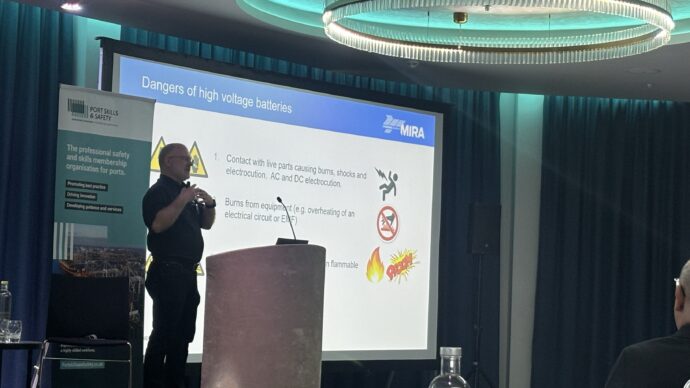NEWS
New Energy Vectors: The risks of future transport
Campaigns |Published: Oct 24, 2024

The second keynote speaker at the Electric Vehicle maritime safety conference was Martin Brown, improvement consultant at HORIBA MIRA, a vehicle research and development organisation. Martin has spent nearly three decades developing, building, and testing prototype vehicle systems. He has developed operational and safety protocols for hybrid and Electric Vehicles (EV) as well as other alternative new energies including hydrogen fuel cells.
Martin explained that HORIBA MIRA use their laboratories and tracks to test vehicle systems and have been dealing with electric vehicles for many years, long before they were commercially available. He said that in the early days of testing EVs they had a lot of fires before realising that they could reignite several days or weeks later – the process now known as thermal runaway.
“The first electric vehicle was actually developed in 1845 and predates internal combustion engine vehicles by about 10 years,” Martin explained. “People liked electric vehicles because their houses were being electrified at this point so they could charge the vehicles up at their houses, and there were public charging stations in towns and villages, and EVs were quiet so they didn’t disturb the horses!”
He went on to explain that this changed because the cars were very expensive to purchase, and the price of electricity rose; so when Henry Ford designed a car that was cheap to buy and affordable to fuel it opened up the market to working class people. This has changed in the last 20 years as climate change has encouraged people to look for cleaner energy, meaning hybrid and Electric Vehicles have grown in popularity, with many manufacturers aiming to produce only EVs by 2035.
Martin reinforced the message around EV risks that Professor Paul Christensen had covered in his opening speech, including the chemical aspects of the battery systems, fires, and electrocution – especially when vehicles have been damaged.
“When fire crews arrive [at an EV fire], the only thing that they can really do is put water on it,” he said. “That’s like the fire service coming to your house and just aiming the water jets at brickwork on the outside and hoping that by cooling the brickwork on the outside, it’s going to put the fire out inside the building. We need to come up with a method where you can actually cool the batteries down.”
Martin explained that there are many variations in battery systems in today’s EVs and they all required different measures to deal with the associated risks. He said that in the early days of modern EVs there had been calls to standardise systems, but this had not happened and the regulators have not kept up with developments. However, he did reassure the audience that EVs did not represent a bigger risk than other systems, just new risks that many people are not aware of.
He encouraged the maritime sector to push for EVs to be transported with 30% battery charge wherever possible but recognised that this was difficult for passengers bringing their own vehicles onto ferries. He added that a car which that had involved in a minor accident many hours before might have unknowingly damaged the battery which could cause it to go into thermal runaway a significant time later.
Martin concluded his speech by calling on the maritime sector to support ongoing calls for standardisation of lithium-ion batteries, noting that as more variations come online, it will be increasingly more difficult for the sector and the fire service to be trained and equipped to deal with the differences.
